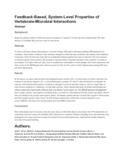Feedback-Based, System-Level Properties of Vertebrate-Microbial Interactions

Date
2013-02-20Author
Rivas, Ariel L.
Jankowski, Mark D.
Piccinini, Renata
Leitner, Gabriel
Schwarz, Daniel
Anderson, Kevin L.
Fair, Jeanne M.
Hoogesteijn, Almira L.
Wolter, Wilfried
Chaffer, Marcelo
Blum, Shlomo
Were, Tom
Konah, Stephen N
Kempaiah, Prakash
Ong’echa, John M.
Diesterbeck, Ulrike S.
Pilla, Rachel
Czerny, Claus-Peter
Hittner, James B.
Hyman, James M.
Douglas J. Perkins, Douglas J.
Metadata
Show full item recordAbstract
Background
Improved characterization of infectious disease dynamics is required. To that end, three-dimensional (3D) data analysis of feedback-like processes may be considered.
Methods
To detect infectious disease data patterns, a systems biology (SB) and evolutionary biology (EB) approach was evaluated, which utilizes leukocyte data structures designed to diminish data variability and enhance discrimination. Using data collected from one avian and two mammalian (human and bovine) species infected with viral, parasite, or bacterial agents (both sensitive and resistant to antimicrobials), four data structures were explored: (i) counts or percentages of a single leukocyte type, such as lymphocytes, neutrophils, or macrophages (the classic approach), and three levels of the SB/EB approach, which assessed (ii) 2D, (iii) 3D, and (iv) multi-dimensional (rotating 3D) host-microbial interactions.
Results
In all studies, no classic data structure discriminated disease-positive (D+, or observations in which a microbe was isolated) from disease-negative (D–, or microbial-negative) groups: D+ and D– data distributions overlapped. In contrast, multi-dimensional analysis of indicators designed to possess desirable features, such as a single line of observations, displayed a continuous, circular data structure, whose abrupt inflections facilitated partitioning into subsets statistically significantly different from one another. In all studies, the 3D, SB/EB approach distinguished three (steady, positive, and negative) feedback phases, in which D– data characterized the steady state phase, and D+ data were found in the positive and negative phases. In humans, spatial patterns revealed false-negative observations and three malaria-positive data classes. In both humans and bovines, methicillin-resistant Staphylococcus aureus (MRSA) infections were discriminated from non-MRSA infections.
Conclusions
More information can be extracted, from the same data, provided that data are structured, their 3D relationships are considered, and well-conserved (feedback-like) functions are estimated. Patterns emerging from such structures may distinguish well-conserved from recently developed host-microbial interactions. Applications include diagnosis, error detection, and modeling.
Collections
- Gold Collection [1026]
